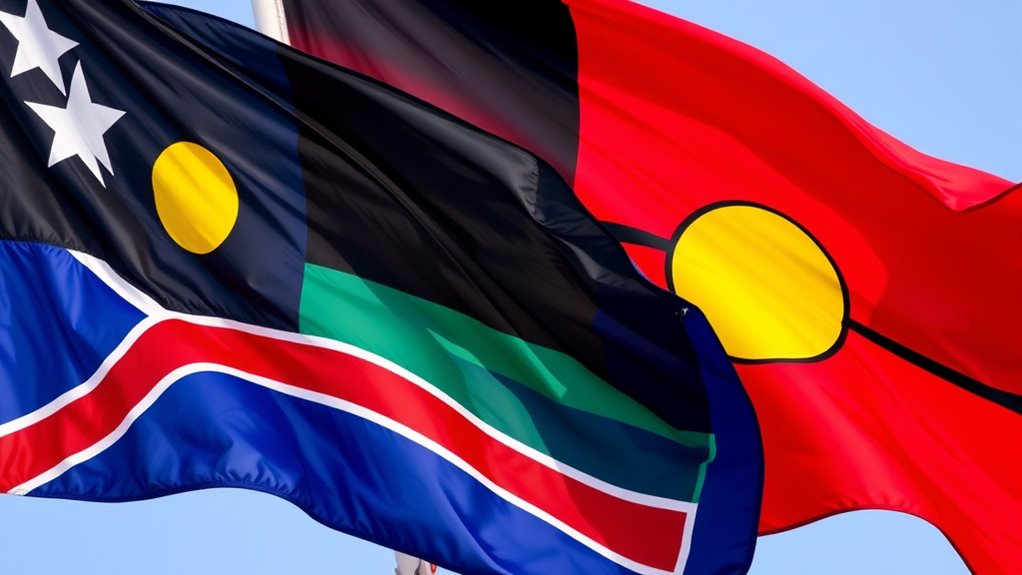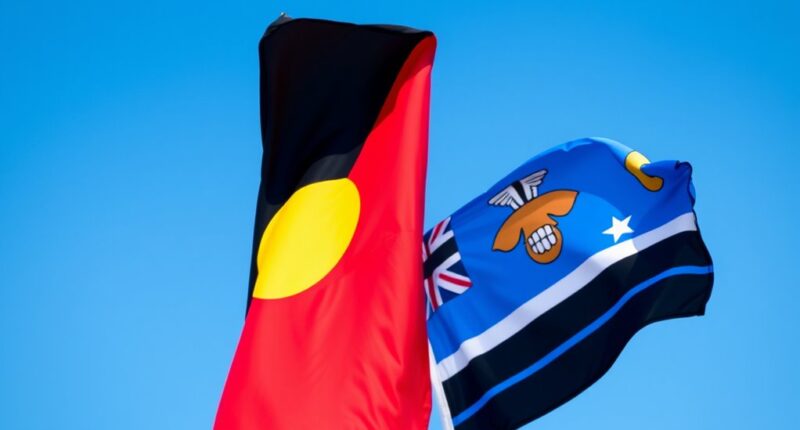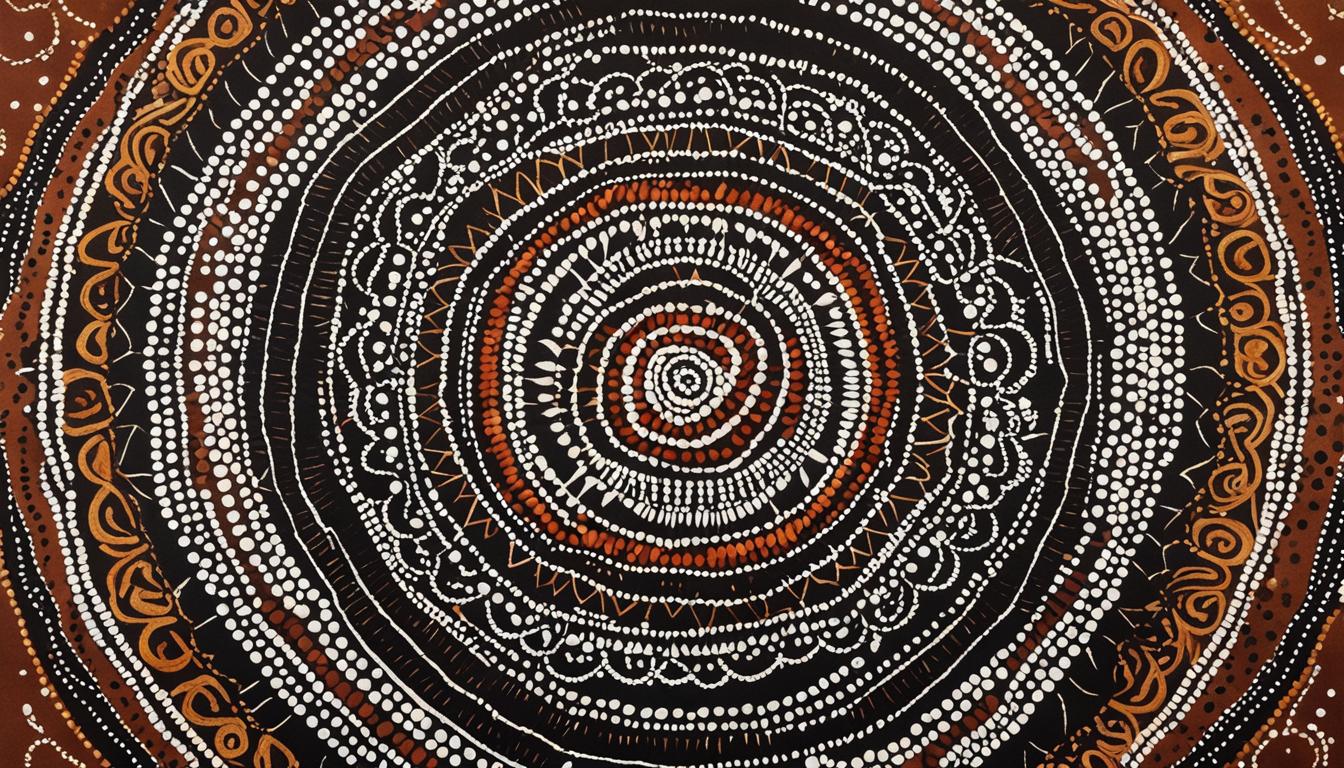The Aboriginal and Torres Strait Islander Flags use powerful symbols to express cultural identity, land, and spiritual beliefs. The Aboriginal Flag features black, red, and yellow, representing the people, land, and sun’s life-giving energy. The Torres Strait Islander Flag shows green, blue, white star, and a Dhari headdress, symbolizing land, sea, navigation, and cultural pride. Understanding these symbols helps you appreciate the deep history and resilience behind each flag—keep exploring to uncover more of their meaning.
Key Takeaways
- The black on the Aboriginal flag represents Indigenous people and spiritual connection to land, while the red symbolizes the earth and sacrifices.
- The yellow circle on the Aboriginal flag signifies the sun, life, and spiritual energy.
- The green on the Torres Strait Islander flag represents land and lush islands; blue symbolizes surrounding seas.
- The white star on the Torres Strait Islander flag signifies hope and navigation, representing the five island groups.
- Both flags’ symbols embody cultural identity, land-sea connection, resilience, and ongoing efforts for recognition and unity.

The flags of Aboriginal and Torres Strait Islander peoples are powerful symbols that convey deep cultural meanings, but understanding their designs can sometimes be confusing. When you look at these flags, you’re seeing more than just colors and shapes; you’re witnessing visual expressions of history, identity, and connection to land and community. Recognizing the cultural significance behind each element helps you appreciate what these flags represent and why they matter so profoundly to Indigenous Australians. The Aboriginal flag features a simple yet meaningful design: a black top half, a red bottom half, and a yellow circle in the center. The black symbolizes the Aboriginal people and their spiritual connection to the land, which is fundamental to their identity. The red reflects the earth, symbolizing the land itself, as well as the blood and sacrifice of those who fought to preserve their rights and culture. The yellow circle represents the sun, a source of life, warmth, and spiritual energy. These design symbols encapsulate the relationship between Indigenous Australians and their land, emphasizing respect, resilience, and harmony with nature. Additionally, understanding the symbolic elements of the flags fosters a deeper respect for their profound cultural importance. Similarly, the Torres Strait Islander flag employs a design that vividly portrays the islands’ cultural identity. It features a green upper half, representing the land and the lush islands, and a blue lower half, symbolizing the seas that connect and sustain the Torres Strait community. A white five-pointed star sits in the center, symbolizing hope, navigation, and the five island groups within the Torres Strait. A white Dhari, or headdress, overlays the star, representing Torres Strait Islander culture, identity, and traditional authority. Each element in this flag is carefully chosen to communicate a sense of unity, cultural pride, and the importance of land and sea in their lives. Understanding these design symbols enhances your appreciation of the flags’ cultural significance. They’re not just decorative; they’re powerful statements of identity, resilience, and spiritual connection. When you see these flags flown, you’re witnessing more than a symbol—you’re recognizing stories, struggles, and a shared commitment to preserving culture. The colors, patterns, and symbols serve as visual language, communicating values that have endured through generations. In essence, decoding these flags involves more than understanding their design symbolism; it’s about respecting the profound meaning they hold for Aboriginal and Torres Strait Islander peoples. They are living symbols that honor history, land, and community, reminding everyone of the importance of cultural identity and the ongoing journey toward recognition and reconciliation.
Frequently Asked Questions
How Did the Flags Originate Historically?
You might wonder how these flags originated historically. The flags were created to symbolize the identity and unity of Aboriginal and Torres Strait Islander peoples, carrying deep historical significance. The Aboriginal flag was designed in 1971 to represent the land, culture, and spiritual connection, while the Torres Strait Islander flag was introduced in 1992 to celebrate their unique heritage. Both flags serve as powerful symbols of pride and recognition.
Who Designed the Aboriginal and Torres Strait Islander Flags?
Ever wonder who created the powerful symbols on these flags? You might be surprised to learn that the Aboriginal Flag was designed by Harold Thomas in 1971, while the Torres Strait Islander Flag was created by David Ross in 1992. Both designs carry deep cultural significance and rich symbolism interpretations, representing identity, heritage, and connection to land and sea. Their creators’ intentions guarantee these flags remain essential symbols of pride and cultural unity.
Are There Any Official Guidelines for Flag Usage?
You might wonder if there are official guidelines for flag usage. Yes, there are, which help uphold the flags’ cultural significance and ensure respectful display. These guidelines provide legal protections, preventing misuse or disrespect. By following them, you honor the symbols’ importance to Aboriginal and Torres Strait Islander communities. Proper usage maintains the flags’ integrity and reinforces their role as powerful symbols of identity and cultural heritage.
How Are These Flags Recognized Internationally?
You might wonder how these flags are recognized internationally. Their symbol recognition varies, but their cultural significance is widely acknowledged, especially at events honoring Indigenous peoples. Countries and organizations often display these flags to show respect and solidarity. While they may not have official status everywhere, their powerful symbols promote awareness, understanding, and recognition of Aboriginal and Torres Strait Islander cultures worldwide, highlighting their importance beyond Australia’s borders.
Can Individuals or Organizations Create Their Own Versions?
You can create your own versions of flags through flag customization, but you should be aware of copyright considerations. While designing a unique flag is possible, copying or closely mimicking official flags may infringe on intellectual property rights. It’s best to verify your design is original and respectful, especially if you plan to display or distribute it publicly. Always check relevant copyright laws to avoid any legal issues.
Conclusion
As you now see, these flags are more than just colors and shapes—they’re the heartbeat of a rich, resilient culture. Every symbol pulses with history, pride, and hope, making them powerful emblems that can move mountains and inspire generations. By understanding their meaning, you’re revealing a world of stories and strength that can transform how you see and honor these incredible communities. Their symbols aren’t just symbols—they’re the soul of a nation.









